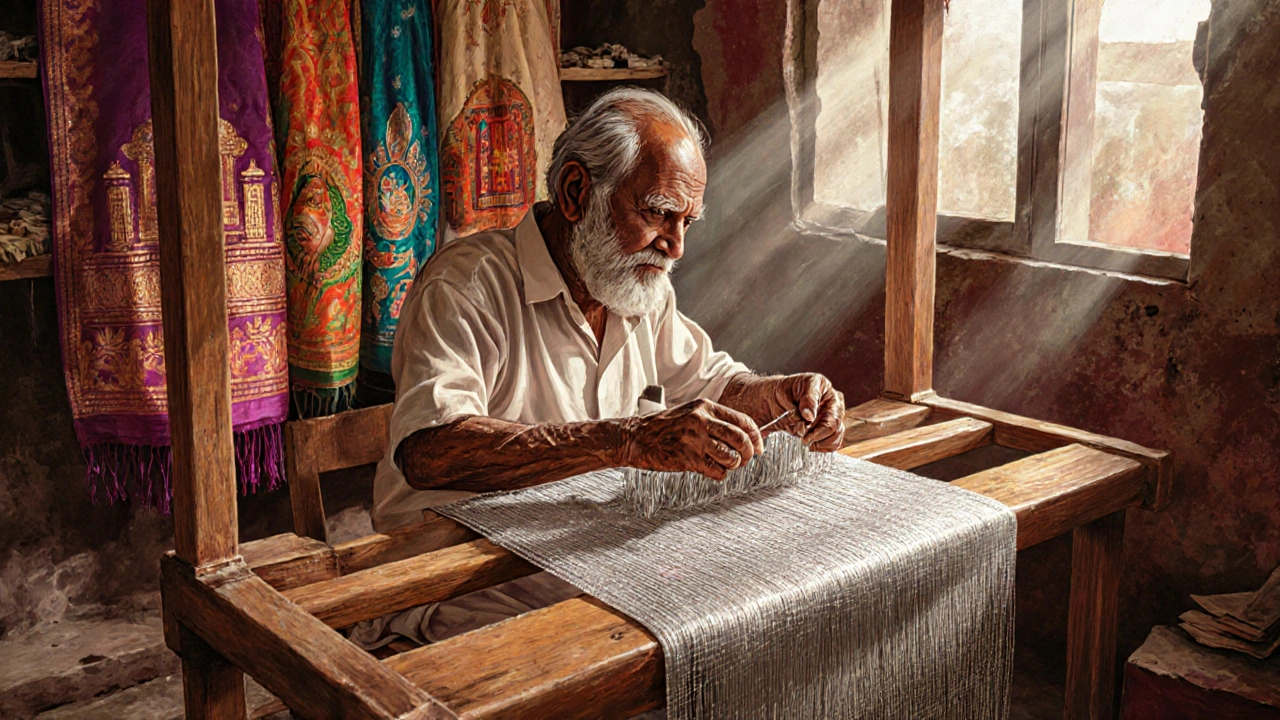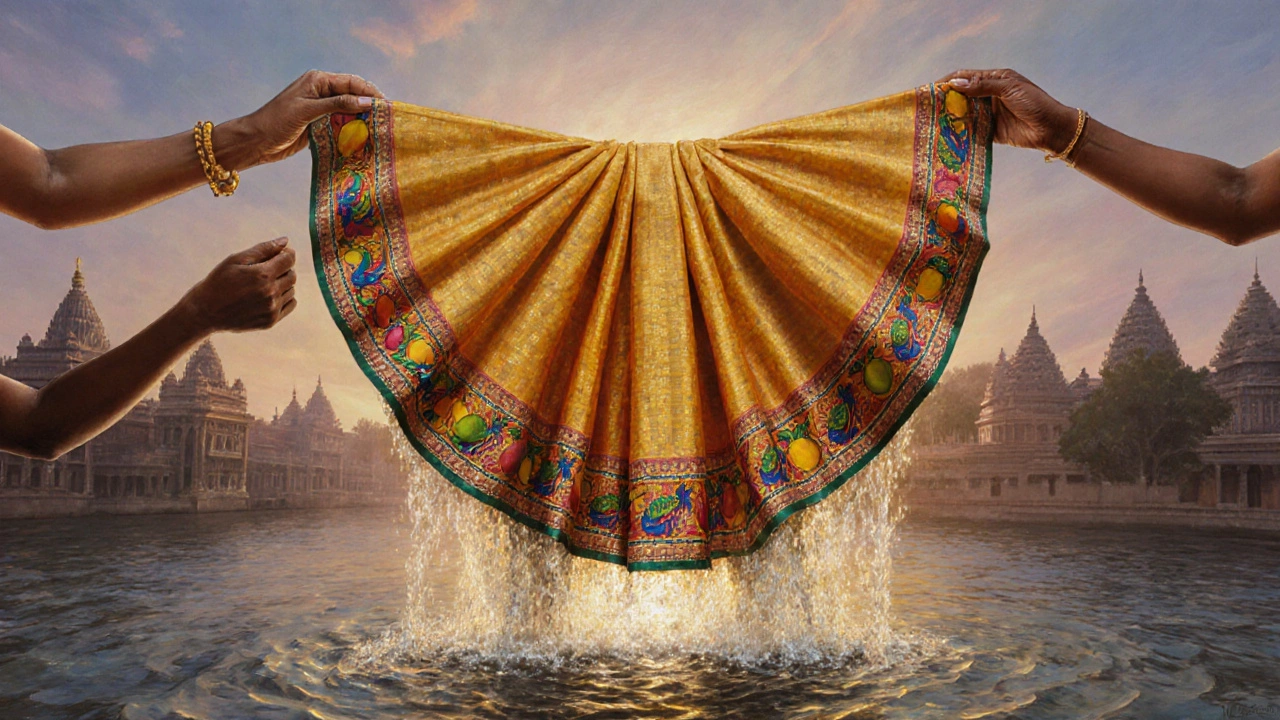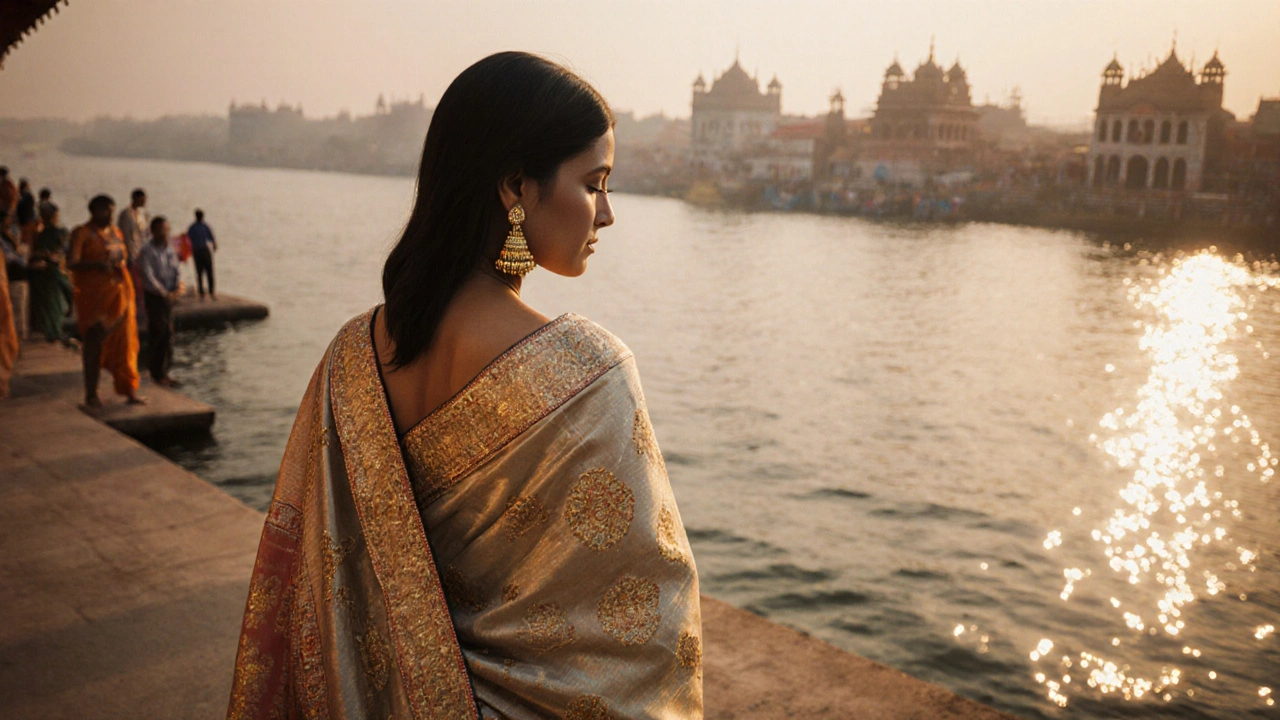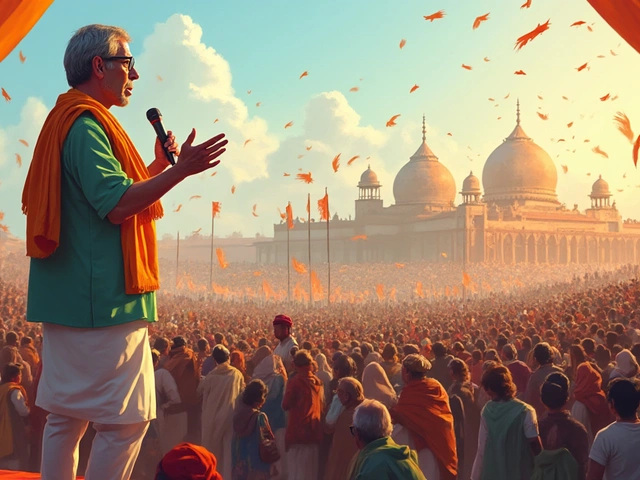Which Saree Is Famous in Prayagraj? The Traditional Banarasi Silk That Defines the City’s Identity
When you walk through the bustling lanes of Prayagraj, especially near the ghats of Sangam or the old markets around Chowk, you’ll see women draped in sarees that shimmer like liquid gold. These aren’t just any sarees-they’re Banarasi silk sarees, the heart and soul of Prayagraj’s textile legacy. If you’re asking which saree is famous in Prayagraj, the answer is simple: it’s the Banarasi silk saree. Not because it’s the only one, but because it’s the one that carries centuries of craft, ritual, and identity in every thread.
Why Banarasi Silk Is the Soul of Prayagraj
Prayagraj, formerly known as Allahabad, sits in the heart of Uttar Pradesh, a state that’s produced some of India’s finest handwoven textiles. But among all the regions-Varanasi, Kanpur, Lucknow-it’s Banarasi silk that dominates the sartorial landscape here. The connection isn’t accidental. Banarasi silk has been woven in this region since the Mughal era, when weavers from Varanasi migrated to nearby towns like Prayagraj, bringing their looms and techniques with them.
Today, you’ll find dozens of small workshops in the Sadar Bazaar and Khusro Bagh areas where master weavers still use traditional handlooms. These aren’t factory machines. They’re wooden frames passed down through generations, operated by skilled artisans who can weave a single thread of zari (metallic thread) for hours without a mistake. A single Banarasi saree can take anywhere from 15 days to six months to complete, depending on the complexity of the design.
What Makes a Banarasi Saree Different?
Not all silk sarees are created equal. Banarasi silk stands out because of three things: the material, the weave, and the zari.
- Material: True Banarasi silk uses mulberry silk from Karnataka or Tamil Nadu, spun into fine, lustrous threads. The base fabric is dense but lightweight, making it ideal for hot climates like Prayagraj’s.
- Weave: The hallmark is the jamdani or kinkhab weave-where intricate patterns are woven directly into the fabric, not printed or embroidered. This gives the design a raised, three-dimensional look.
- Zari: Traditionally made from real silver or gold wire, today’s zari is often copper or polyester coated with metal. But in Prayagraj’s best workshops, you’ll still find artisans using pure silver zari, especially for bridal pieces.
Look closely at the border. A real Banarasi saree will have a butidar pattern-tiny floral or paisley motifs that repeat like a silent poem. The pallu (the loose end draped over the shoulder) often features elaborate motifs: peacocks, mangoes, or temple designs. These aren’t random decorations. Each symbol carries meaning. The mango represents fertility. The peacock, grace. The temple, devotion.
The Cultural Weight of a Banarasi Saree in Prayagraj
In Prayagraj, a woman doesn’t just wear a Banarasi saree-she wears her heritage. At the Kumbh Mela, when millions gather at Sangam, you’ll see grandmothers, brides, and priests all draped in Banarasi silk. It’s not fashion. It’s ritual. The saree is part of the offering, part of the ceremony, part of the identity.
For many families, buying a Banarasi saree is a rite of passage. A daughter might receive her first one at her wedding. A mother might save for years to buy one for her daughter’s engagement. These aren’t impulse purchases. They’re heirlooms. Some families keep Banarasi sarees for three generations, passing them down with care, washing them by hand in rosewater, storing them in sandalwood boxes.
Even in daily life, you’ll see women in Prayagraj wearing lighter Banarasi cotton-silk blends for temple visits or family gatherings. The fabric is breathable, elegant, and carries a quiet dignity that no synthetic fabric can match.

Where to Buy Authentic Banarasi Silk in Prayagraj
If you’re visiting Prayagraj and want to buy a real Banarasi silk saree, avoid the tourist stalls near the railway station. Those are mass-produced imitations with printed zari and synthetic silk.
Instead, head to:
- Sadar Bazaar: The oldest market in the city. Look for shops with signs like “Original Banarasi Handloom”. Ask to see the weaver’s mark-a small tag sewn into the border that says the workshop name.
- Khusro Bagh: A quiet lane lined with family-run boutiques. Here, you can watch weavers at work and even commission a custom design.
- Shahganj: Known for bridal collections. Many shops here offer embroidery customization, like adding pearls or Kundan stones to the pallu.
Price range? A basic Banarasi cotton-silk saree starts at ₹8,000. A full silk piece with heavy zari can cost ₹25,000 to ₹1,20,000. The most expensive ones-woven with pure silver zari and 10,000+ hours of labor-go beyond ₹2 lakh. But even the cheapest ones here are handmade. That’s the difference.
How to Spot a Fake Banarasi Saree
Counterfeits are everywhere. Fake Banarasi sarees use polyester silk, printed patterns, and cheap metallic threads that tarnish after one wash. Here’s how to tell real from fake:
- Check the weave: Real Banarasi has uneven threads on the back-handwoven imperfections. Machine-made ones are perfectly smooth.
- Test the zari: Rub a small piece of the border with a soft cloth. Real zari won’t flake. Fake zari leaves metallic dust.
- Smell it: Real silk has a faint, earthy scent. Synthetic silk smells like plastic.
- Ask for proof: Reputable sellers will show you a government-certified Geographical Indication (GI) tag. Look for the blue GI logo on the label.
Don’t be shy to ask questions. A real weaver will be proud to explain how long it took to make the saree, who wove it, and what the patterns mean.

Why This Tradition Is Still Alive
With factories churning out cheap copies and younger generations moving to cities, you’d think Banarasi weaving would be dying. But in Prayagraj, it’s not. Why?
Because the people here still believe in it. Women still wear these sarees to weddings, religious events, and even funerals. Local NGOs and the Uttar Pradesh Handloom Board have started training young women in weaving. Schools teach children about the history of their textiles. In 2023, the Prayagraj Municipal Corporation launched a “Saree Heritage Trail,” guiding tourists to authentic weavers.
And it’s working. Sales of handwoven Banarasi sarees in Prayagraj rose by 32% between 2022 and 2024, according to the state’s handloom department. The buyers? Not just locals. Young women from Delhi, Bengaluru, and even abroad are coming here to buy directly from the weavers.
This isn’t just about clothing. It’s about preserving a way of life. Every Banarasi saree from Prayagraj carries the sweat of a weaver, the patience of a grandmother, the prayers of a bride. It’s not just silk and zari. It’s memory woven into fabric.
What to Wear With a Banarasi Saree in Prayagraj
When you wear a Banarasi saree here, you don’t just wear it-you honor it. The traditional pairing is a simple gold or silver choker, and jhumkas (dangling earrings) that match the zari. No heavy necklaces. The saree is the statement.
For daytime, pair it with minimal makeup and a bindi. For evening events, add a small waist belt (kamarband) with a silver clasp. Footwear? Barefoot at temples. Embroidered juttis for weddings.
And never, ever dry-clean it. Hand-wash in cold water with mild soap. Lay flat to dry. Store in cotton cloth, never plastic. These sarees are alive. Treat them that way.
Is Banarasi silk only from Varanasi?
No. While Varanasi is the most famous origin, Banarasi silk weaving spread to nearby cities like Prayagraj, Mirzapur, and Bhadohi centuries ago. These regions developed their own styles and techniques. Prayagraj’s version is known for slightly heavier zari and more temple-inspired motifs, while Varanasi leans toward floral and paisley patterns. Both are authentic, but Prayagraj’s sarees are deeply tied to local rituals and festivals.
Can I wear a Banarasi saree outside of weddings?
Absolutely. While heavy Banarasi sarees are common at weddings, lighter cotton-silk blends are worn daily in Prayagraj for temple visits, family functions, and even office wear. Many women in the city own three to five Banarasi sarees-one for each season. The key is matching the weight and design to the occasion.
Are Banarasi sarees expensive because of the material or the labor?
It’s mostly the labor. The silk itself isn’t the most expensive fabric in India. But each saree takes 15 to 180 days to weave by hand. A single weaver might only finish two sarees a year. That’s why prices reflect time, not just material. A ₹15,000 saree isn’t cheap silk-it’s 200 hours of skilled craftsmanship.
Do men wear Banarasi fabric in Prayagraj?
Yes, but not as sarees. Men wear Banarasi silk in turbans (pagri), waistcoats (bandhgala), and dhoti borders during religious ceremonies. The same zari and weave are used, but the designs are more geometric and less ornate. It’s a quieter expression of the same heritage.
How do I care for a Banarasi saree I bought in Prayagraj?
Never machine wash. Hand wash in cold water with a drop of mild shampoo. Soak for 10 minutes, gently swirl, rinse twice. Hang in shade-never direct sun. Iron on silk setting with a cotton cloth over it. Store folded in a cotton cloth inside a wooden box with neem leaves to prevent moths. Avoid plastic bags-they trap moisture and damage zari.
If you want to understand what makes Prayagraj unique, don’t just visit the ghats or the fort. Walk into a weaver’s home. Watch the shuttle fly. Feel the weight of a saree that took a lifetime to make. That’s the real answer to which saree is famous here. It’s not just a cloth. It’s a story stitched into every thread.






14 Comments
Anuj Kumar
November 5 2025Everyone says Banarasi is sacred but let me tell you something - most of these ‘handwoven’ sarees are now made in China with laser-cut zari and shipped to India with fake GI tags. The weavers? They’re ghosts. The real ones died years ago. This whole thing is a government-funded illusion to keep tourists spending.
Christina Morgan
November 7 2025This is one of the most beautiful cultural deep dives I’ve read in months. The way you described the symbolism in the motifs - peacocks for grace, mangoes for fertility - it’s like poetry woven into fabric. As an American who’s worn a Banarasi to a Diwali party, I felt deeply seen. Thank you for honoring this tradition with such care.
Kathy Yip
November 8 2025im not sure if i understood this right but like… is the zari real silver or just fake? i mean i read something about it being copper coated but then you said some are still using pure silver? also… how do you even store something like that? i think i’d be scared to touch it lol
Bridget Kutsche
November 10 2025Love this so much. If you’re even thinking about buying one, do it. Not because it’s ‘expensive’ but because you’re supporting someone’s legacy. I bought a cotton-silk blend last year for my mom’s 60th - she cried when she opened it. Now it’s her Sunday-go-to-church outfit. That’s the power of something made with patience.
Jack Gifford
November 11 2025Minor grammar note: ‘weavers from Varanasi migrated to nearby towns like Prayagraj’ - should be ‘who migrated,’ not ‘that migrated.’ But otherwise, fantastic piece. The detail about the GI tag and how to spot fakes? Gold. Everyone needs to read this before buying online.
Sarah Meadows
November 12 2025Let’s be real - this isn’t heritage. It’s cultural protectionism dressed up as art. The West fetishizes ‘artisanal’ Indian textiles while ignoring the labor exploitation behind them. The weavers get pennies. The middlemen profit. The tourists take selfies. This whole narrative is a colonial fantasy with a ₹1.2 lakh price tag.
Nathan Pena
November 14 2025Let’s analyze the economic inefficiency: 180 days of labor for a ₹200,000 saree equates to roughly ₹11 per hour - below India’s minimum wage in urban centers. This isn’t craftsmanship; it’s a subsidy-dependent relic. The real tragedy? The younger generation is fleeing this unsustainable model. The romanticization of ‘handwoven’ is just a distraction from systemic failure.
Mike Marciniak
November 14 2025They say Banarasi silk is authentic but have you ever checked where the silk actually comes from? Karnataka and Tamil Nadu? That’s not local. That’s supply chain manipulation. And the GI tag? It’s a bureaucratic loophole. The real truth? This entire industry is controlled by a cartel that prevents new weavers from entering the market. They want you to believe it’s tradition - it’s monopoly.
VIRENDER KAUL
November 16 2025It is a matter of profound regret that the younger generation has lost all sense of reverence for the ancient art of handloom weaving. The commercialization of cultural artifacts into mere fashion statements is a clear indicator of societal decay. The sanctity of the saree as a vessel of ancestral memory is being eroded by consumerist impulses and digital distractions. One must ask: what future awaits a civilization that no longer honors its weavers?
Mbuyiselwa Cindi
November 17 2025Wow. This made me want to fly to Prayagraj tomorrow. I’ve never held a Banarasi, but I’ve seen my aunt wear something similar back home in South Africa - it was a Xhosa ceremonial wrap, also handwoven, also passed down. There’s something sacred about cloth that holds stories. Thank you for sharing this.
Henry Kelley
November 19 2025Just read this while sipping chai and I’m genuinely moved. I used to think ‘handmade’ was just a marketing word, but now I get it. That moment when you realize someone spent six months making something just to wear it once? That’s love. I’m gonna find a local weaver and order one for my sister’s wedding. No more fast fashion for us.
Victoria Kingsbury
November 19 2025Okay but let’s talk about the zari supply chain. The ‘pure silver’ claim? Most of it’s now electroplated copper with a silver finish. The GI tag helps, but there’s zero independent auditing. And the ‘10,000+ hours’? That’s only if you’re counting the weaver’s lifetime - most are paid per piece, not per hour. This is artisanal capitalism with a pretty veneer.
Tonya Trottman
November 21 2025Oh wow. So the ‘temple motifs’ are ‘devotion’? And the peacock? ‘Grace.’ Cute. Let me guess - the mango is ‘fertility’ because apparently women are just walking orchards now? This whole thing reads like a Pinterest board written by someone who watched one episode of ‘Indian Handicrafts Uncovered.’ Also, ‘never dry clean’? Bro. It’s silk. You don’t need a PhD to know that.
Santhosh Santhosh
November 22 2025I remember when I was a boy in Prayagraj, my grandmother would wake before dawn to wash her Banarasi saree in the Sangam water, whispering prayers as she did. She said the river purified not just the fabric but the soul of the person who wore it. She never wore it to market or to the doctor - only for puja, for weddings, for when the family gathered. I never understood why until I moved away. Now, when I see a Banarasi in a mall, I feel like I’m seeing a ghost. Not because it’s fake - but because it’s forgotten. The looms still click in Sadar Bazaar, but no one listens anymore. The threads are still there. But the silence? That’s what’s dying.